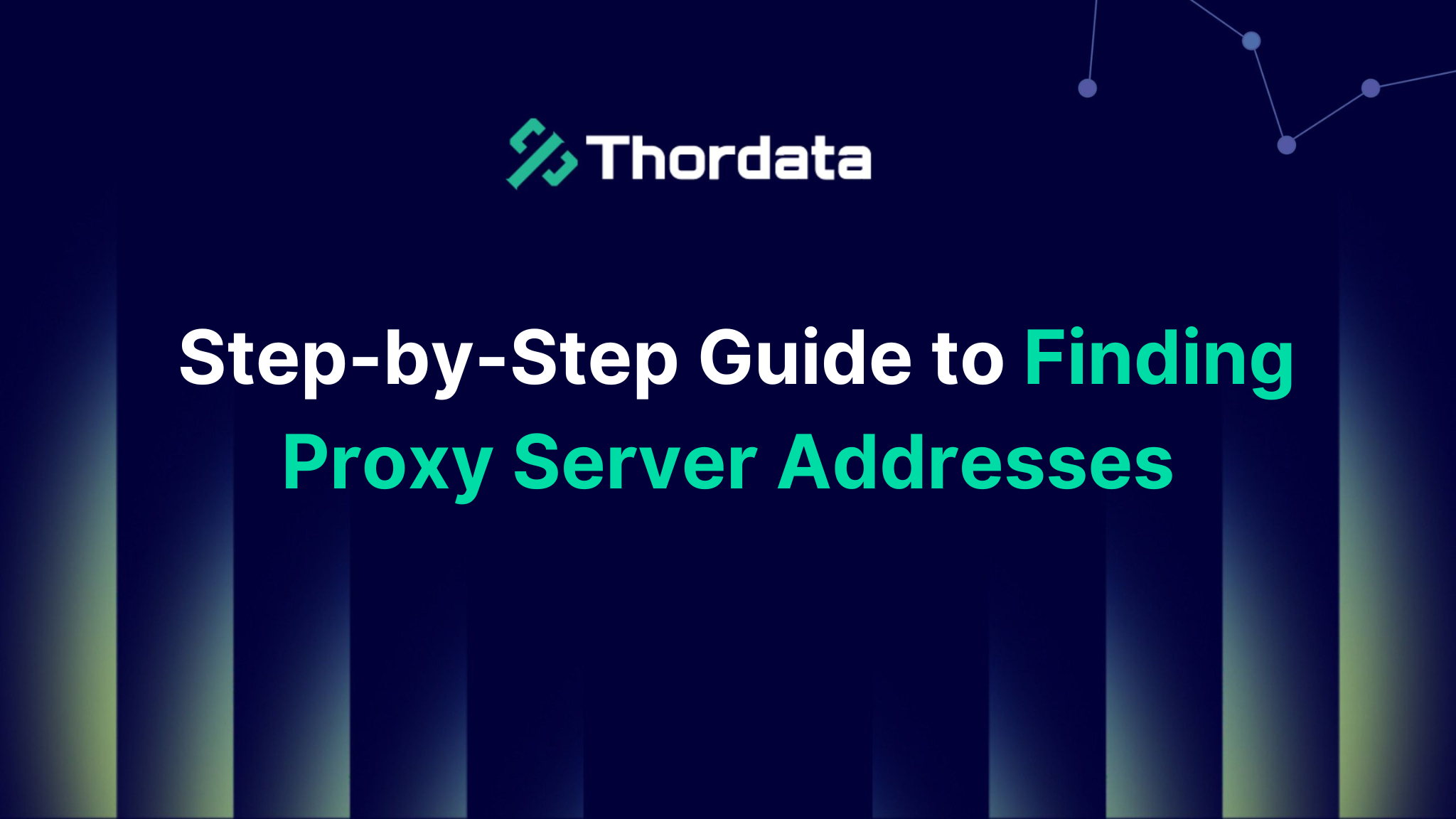Step-by-Step Guide to Finding Proxy Server Addresses


In today’s Internet environment, it is more important than ever to maintain privacy and security while browsing the Internet. And private proxies servers can help you achieve this goal. It has become an indispensable tool for ensuring privacy, improving efficiency, circumventing geographical restrictions, and preventing abuse. Whether you are using a desktop browser or a mobile device, it is crucial to know how to find the proxies servers address. Let’s take a look at how to find the proxies server address on different browsers and mobile devices.
What is a proxy server?
A proxy server is an intermediary between the client and the Internet (the target server). When you use a proxy server, your network requests will be routed through the address of the proxies server, thereby hiding your actual IP address. By using a proxy, you can access websites blocked by geographical restrictions or bypass various network censorship mechanisms.
Common types of proxy servers
HTTP Proxy: Mainly used to handle HTTP protocol requests.
HTTPS Proxy: An HTTPS proxy is the same as an HTTP proxy but has an added layer of security designed to secure encrypted connections using SSL.
SOCKS Proxy: Supports more protocols, not just HTTP.It is an ideal option for use cases where traffic needs to be routed through a proxy server without data interpretation or filtering.
Residential Proxy: A Residential proxy uses real IP addresses attached to physical locations. It provides an excellent level of anonymity and proves specifically helpful when accessing geo-restricted content, web data scraping, and market price monitoring.
Finding a proxy server address on your Browsers
Google Chrome
Chrome itself does not have a built-in proxies settings option, but it will use the system’s network proxies settings.
To find the proxies server address, follow these steps:
1.In the upper right corner of the browser, click the“three dots” menu and select Settings.
2.In the System section, click the“proxies switchyOmega is controlling this setting”(Mannage).
3.Open the network settings of your operating system. On Windows, it will jump to “Internet Options”, and on Mac it will enter the system’s proxiessettings section.
View the configured proxies server address.

Firefox
Firefox provides a built-in proxies settings option that allows users to configure the proxies server address directly in the browser.
1.Open the settings: In the upper right corner of the browser, click the“three horizontal lines menu and select Options”.
2.Find Network Settings and click Settings.
3.In the Connection Settings window, you will see the proxiesconfiguration options. If a proxiesis already configured, you can view the corresponding address and port. If necessary, you can also enter a new proxies server address here.

Safari
Safari’s proxies settings rely on the macOS system’s network settings, so they can be viewed through the system’s network preferences.
1.Open System Preferences: Click the“Apple icon”in the upper-left corner of the screen and select System Preferences.
2.In System Preferences, click“Network”.
3.Select the current network connection (such as Wi-Fi) on the left, then click “Advanced”.
Under the Proxies tab, you will see the currently configured proxies server address.

Microsoft Edge
Similar to Chrome, the Edge browser also relies on the system’s proxies settings, so you need to check the proxies server address through the operating system settings.

Finding a proxy server address on your mobiles
iOS
Open Settings on your iOS device.
Tap Wi-Fi and select the connected Wi-Fi network.
Scroll down to the HTTP proxies section.
Here, you will see the proxies server address.
Android
Open Settings on your Android device.
Depending on your device, tap Network & Internet or Connections.
Select Wi-Fi and tap the connected Wi-Fi network.
Tap Advanced or Modify Network.
Scroll down to the proxies section to find the proxies server address.
Finding a proxy server address on your computer
Windows
On Windows, proxies server settings are usually viewed and configured through Internet Options.
1.Open the Control Panel: Press“Win + R”to open the Run dialog box, type control, and then press Enter to open the Control Panel.
2.In the Control Panel, click“Network and Internet”, and then select Internet Options.
3.In the Internet Options dialog box, switch to the Connections tab.
4.Click the“Local Area Network (LAN) “Settings button.
5.In the dialog box that pops up, if Use a proxiesserver for your LAN is checked, you will see the address and port number of the proxiesserver. If it is not checked, it means that there is currently no proxies server configured.
6.Find the proxiesthrough Windows Settings.
MacOS
In macOS, proxies server settings can be viewed through System Preferences.
1.Open System Preferences
Click the “Apple icon”in the upper-left corner of the screen and select System Preferences.
2.Enter network settings
In System Preferences, click“Network”.
3.View proxiessettings
Select the current network connection (such as Wi-Fi) on the left, then click the Advanced button.
Switch to the proxies tab, where you will see the configured proxies server address.
Linux System
In Linux, proxies settings may vary for different distributions and desktop environments. Here are the steps using the Ubuntu desktop environment.
1.Open System Settings. Click“Network”, then select Network proxies.
2.You can view and configure proxiessettings. If a proxiesserver is configured, you will see the proxies address and port.
Finding a proxy server address using CMD
Windows Command Line
Open Command Prompt (Press Win + R, type cmd and hit Enter).
Enter the following command to view proxies settings:
netsh winhttp show proxies
This command will display the proxies server settings for the current Windows system.
MacOS Terminal Command
Open Terminal.
Enter the following command to view proxies settings:
scutil –proxies
This command will display the proxies settings for the macOS system.
Important considerations when using a proxy server
Even though using proxies comes with a wide range of benefits, some important considerations need your attention:
Using a proxy server can have a negative impact on your internet connection, slowing down the browsing speed and performance. So, there is a possibility of experiencing bandwidth issues and delays.
In terms of ethical usage, attempting to access unauthorized networks through proxies might violate copyright laws.
In a Nutshell,Thordata is an efficient and secure proxy service designed for users who need anonymity, high-speed connections, and global proxy access. For detailed configuration, please view the quick guide.
We have put together some tutorials on integrating Thordata Residential Proxies with third-party tools to help you get started, View Documentation.
Thordata offers 24/7 support. If you have any questions or need assistance, please contact us at support@thordata.com.
Conclusion
Knowing how to find and configure proxies server addresses is a valuable skill to enhance online privacy and security. Whether you are using a desktop browser or a mobile device, the above steps will help you quickly find the necessary settings.
A proxies server is a powerful tool that can help users improve network efficiency, protect privacy, and bypass geo-blocking in various scenarios. Whether you are doing data scraping, SEO optimization, or need to protect personal privacy, Thordata can provide you with reliable and stable proxies services.
Frequently asked questions
Is the proxies address the same as an IP address?
No, a proxies address is not the same thing as an IP address. An IP address identifies your device on the internet, while a proxies address is a server address that hides your IP and acts as a middleman between you and the internet.
How to find a proxies address for WiFi?
A web proxies server address for WiFi can usually be found on the settings of your browser or mobile device. There, you’ll be able to see the proxies address if it’s configured.
Where can I find a proxies server address?
To find a proxies server address on your device, you need to follow a specific set of steps which is fairly similar for various browsers and devices. For example, to find a proxies server address on Safari, click on “Safari” in the top menu bar, select “Settings,” go to the “Advanced” tab, and click on “Change Settings” next to Proxies.
About the author
Jenny is a Content Manager with a deep passion for digital technology and its impact on business growth. She has an eye for detail and a knack for creatively crafting insightful, results-focused content that educates and inspires. Her expertise lies in helping businesses and individuals navigate the ever-changing digital landscape.
The thordata Blog offers all its content in its original form and solely for informational intent. We do not offer any guarantees regarding the information found on the thordata Blog or any external sites that it may direct you to. It is essential that you seek legal counsel and thoroughly examine the specific terms of service of any website before engaging in any scraping endeavors, or obtain a scraping permit if required.